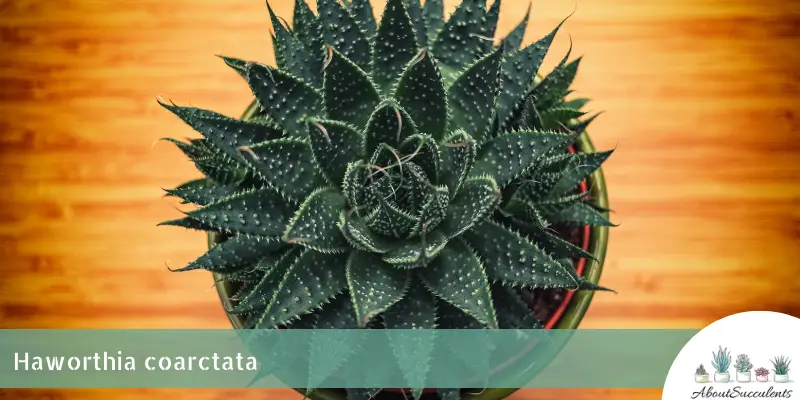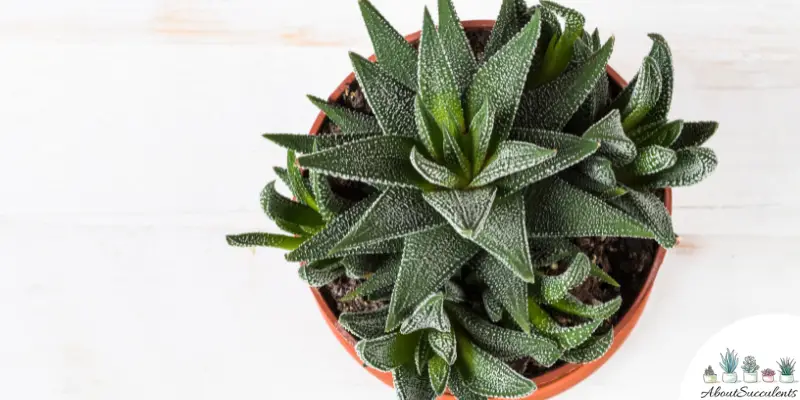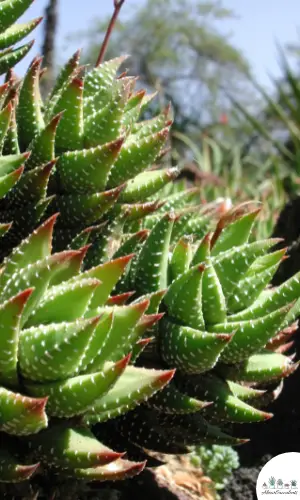
Haworthia Coarctata, also known as Aloe Coarctata is a robust succulent that produces clumps of fleshy leaves that have distinct white, bands or pearly tubercles.
Aloe Coarctata can reach up to 20cm (8”) tall and 5cm (2”) wide. The rosettes of dark green leaves grow up to 30 cm (12”) in length when they reach full maturity. When grown exposed to full sun, the leaves acquire a rich purple-red hue.
During spring Haworthia Coarctata blooms greenish-white, tubular flowers on its stems that shoot up to 30cm (11”) high atop the foliage.
Haworthia Coarctata is a native to the Eastern Cape Province, South Africa. It belongs to the Haworthia genus from the Asphodelaceae family.
General Information:
Also known as: Aloe Coarctata
Plant Family: Asphodelaceae
Origin: Eastern Cape Province of South Africa
Height: 20cm (8”)
Exposure: Full Sun to partial shade for up to 6 hours
Water needs: Drought-resistant; use the “soak and dry” method of watering
Soil Type: Standard succulent soil mixed with organic matter and gritty materials such as sand, gravel, pumice, or perlite
Soil ph: 5.0 to 7.0
How to Grow and Care for Haworthia Coarctata

Haworthia Coarctata is an easy-to-care-for succulent that you can grow indoors or outdoors. It makes for a great filler for your rock garden and as an ornament adorning your windowsill.
The Aloe Coarctata is not cold-hardy and can thrive in locations with temperatures of -1.1° C (30° F) or higher.
Sunlight
Haworthia Coarctata enjoys full sun. However, direct exposure to the midday sun will scorch the leaves.
When planted outdoors, make sure to place it in a location where it can get at least 6 hours of sun in the early morning and late afternoon.
Exposure to little sunlight will cause etiolation. The leaves of your Haworthia Coarctata will stretch thinly towards the direction of the light source.
If you will grow Aloe Coarctata indoors, place the pot on your windowsill where it could get at least 6 hours of bright light.
Watering

Haworthia Coarctata does not require frequent watering. Remember that overwatering will damage the roots which can lead to your plant’s early demise.
Allow the soil to dry out completely before you water again. Before you water, insert a stick into the soil to ensure that there is no moisture left. If the soil is dry, soak it with water.
Avoid pouring water into the rosettes because the trapped water will cause fungal rot.
Come late fall, start to reduce your watering. During winter, water your succulent plant every other month.
Pot and Soil
Your Haworthia Coarctata will grow healthy if you pot them in ceramic or terracotta containers. These are made of breathable materials which will prevent soil moisture retention.
When you purchase succulents from nurseries or plant shops, they are often planted in plastic or glass containers. Make sure to transfer your Haworthia Coarctata into pots suitable for succulents.
Cactus mix is the best soil for your Aloe Coarctata. You can also use garden soil mixed with organic matter and gritty materials such as sand, gravel, pumice, or perlite. This combination allows water to drain fast without losing the soil nutrients needed by your plant.
Use fertilizer that’s specifically formulated for succulents. You can add fertilizer to the soil during summer when Haworthia Coarctata actively grows. Refrain from using fertilizer during winter.
How to Propagate Haworthia Coarctata
You can propagate Senecio barbertonicus via leaf and stem cuttings. Summer and spring are the ideal seasons for
The best time to propagate your Haworthia Coarctata is during spring. They will be ready for transplant by the end of summer.
There are three ways to propagate Haworthia Coarctata: Offsets, leaf cuttings, or seeds.
Method 1: Leaf Cuttings
Step 1: Choose firm and healthy leaves.
Step 2: Cut them from the plant using a sterilized and sharp knife or a pair of pruning shears. You can also twist them off gently from the stem.
Step 3: Leave your cuttings in a warm and dry area for 3 days to allow them to callus.
Step 4: Lay your callused leaves on a well-draining potting mix.
Step 5: Place your container in an area exposed to partial sunlight. Mist the soil 4 to 5 times a day. Transplant your new Aloe Coarctata after the roots and new rosettes have formed.
Method 2: Offsets
Step 1: Check if offsets have already sprouted on the base of your mother plant.
Step 2: Gently pull the offsets from the soil.
Step 3: Place them in a warm area and allow them to dry for 2 to 3 days.
Step 4: Replant your dried offsets in a container filled with succulent soil mixed with gritty materials.
Step 5: Place your pot in an area exposed to indirect sunlight. Use the “soak and dry” method of watering.
Method 3: Seeds
Step 1: Fill your container with sterilized potting soil to prevent weed growth during germination.
Step 2: Place your Haworthia Coarctata seeds on top of the soil.
Step 3: Water the soil until it is fully soaked. Make sure that you keep the soil damp every day. Place the container in an area where it will get a lot of bright light.
Step 4: When your seedlings start to sprout make sure to spray your soil with water regularly to stimulate root growth. Do not water the crowns of your baby succulents to prevent fungal rot.
Frequently Asked Questions
Is Haworthia Coarctata Toxic to Cats and Dogs?
Haworthia Coarctata is listed as non-toxic to dogs and cats on the website of the American Society for the Prevention of Cruelty to Animals (ASPCA).
Why is my Haworthia Coarctata Dying?
If your Aloe Coarctata is looking unhealthy and possibly dying, it might be due to the following:
Overwatering
Drought-resistant Haworthia Coarctata will not grow well in overwatered soil. You need to let the soil dry out completely before you water it again.
Moisture retention causes fungal growth and root rot. If you have overwatered your Haworthia Coarctata, you may be able to salvage the succulent plant if you act quickly.
Examine your plant and cut out the damaged parts with a sanitized knife or pruning shears. Next, gently pull out Haworthia Coarctata from the soil.
Check the roots carefully and remove the rotten ones. Lay your plant on a dry container and leave it in a shaded area.
Fill a terracotta or ceramic pot with fresh succulent soil combined with gravel, pumice, and perlite. Plant your treated Haworthia Coarctata. Use the “soak and dry” method of watering.
If the fungal infestation is severe, propagate the plant using leaf cuttings or offsets. Discard the mother plant.
Pest Infestation
Mealybugs and fungus gnats can infest your treasured Haworthia Coarctata. Mealybugs cause leaves and roots to rot while the larvae of Fungus gnat feed on roots and stunt the growth of your succulents.
To get rid of Mealybugs, spray your plant with diluted neem oil or with 70% isopropyl alcohol. Make sure to check the areas where they could be hiding.
To get rid of fungus gnats, fill a spray bottle with water. Then add a few drops of dish soap into it and spray the soil of your Haworthia Coarctata.
Does Haworthia Coarctata Produce Flowers?
Yes, Haworthia Coarctata blooms pale green tubular flowers in spring.
Last Updated on June 9, 2022 by Sofia Lara